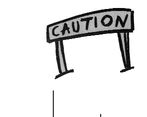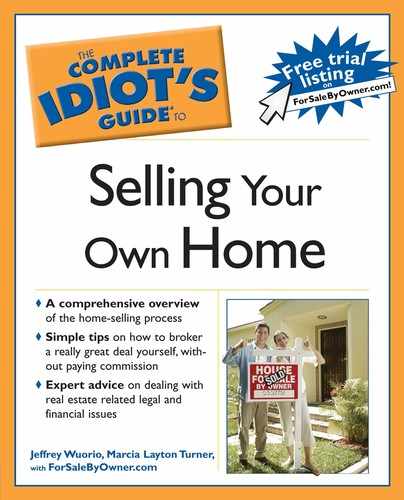Chapter 18
Don’t Be Difficult—The House That Just Won’t Sell
In This Chapter
• Possible reasons offers are scarce
• Strategies for drumming up interest
• Solutions for common turn-offs
• Your fall-back position
Despite your best efforts, it’s still possible your home may not sell as quickly as you’d like. It happens. And if it happens to you, take comfort in the fact that you’re not alone.
The challenge, of course, is diagnosing what’s keeping offers at bay and then fixing them—pronto! And if that doesn’t work, there may be some financial inducements you can offer to attract new buyers. Take heart, it’s by no means a lost cause. This chapter gives you strategies to help you come up with solutions for selling your home.
What’s the Problem?
If you’ve done everything we’ve suggested—decluttering, cleaning, rearranging, and brightening—and your home still has the “For Sale By Owner” sign on your lawn weeks after it first went up, it’s time to take a long, hard look at what’s going on. Is there something about the home that is frightening buyers away?
Interest rates have been low, the housing market has been hot, so unless your particular local real estate market is dead, there may be something buyers are noticing about your home that is turning them off. You haven’t noticed it, of course, so it’s always a good idea to bring in a friend or two, or some real estate agents, to get a fresh perspective.
Ask what they notice when they come in, what they see as the advantages and disadvantages your home has to offer, and what price they would expect your home to fetch. Then match that up to how you perceive your home. Are the two views in sync, or are your expectations unrealistic?
Things to Do When a House Won’t Sell
Depending on what your friends, colleagues, and agents tell you, or what you’ve heard from buyers who’ve toured your home, you may be able to quickly identify a problem area, or two, or three. Some of the most common are odors, busy traffic, or a design defect, such as one bathroom in a four bedroom home. But there are others to watch for as well, most of which have at least partial remedies.
De-Clutter and De-Dirt
The most obvious turn-off for prospective buyers is a home that is dirty and cluttered. For one, it raises the question of how well you’ve maintained the home and whether they’ll have problems because you’ve ignored basic upkeep. Some buyers don’t want to take a chance that they’ll have to do some big repairs after closing because it appears you’re not on top of things. For another, it’s hard to see past piles of paper, clothing, and junk to envision the home as anything but messy. And if buyers can’t picture themselves living in your home, they’ll move on to another one.
The solution, of course, is to further reduce the amount of extra papers, magazines, books, supplies, kitchen tools, toys, and furniture so the home looks bare. Less is more, as they say. If you can’t store it somewhere, box it up and put it in storage.
If you’re concerned about showing a home that looks nothing like how you live in it, don’t be. When buyers are touring a home, they expect to see it at it’s best, which may not necessarily be how you’ve lived in the space the past few years. So do what’s necessary to show off your home’s best features, even if it seems ridiculous to pack up half your closet of clothes or to remove most of your personal photos.
Get Rid of Odors
Although your countertops may be spotless and your closets super organized, if visitors get a whiff of a noxious odor, they’ll be out the door before even getting beyond the front hallway. As someone who has been living in the home, breathing the air regularly, you probably can’t detect pet odors, dirty baby diapers, or the smell of tobacco or cigarette smoke. But someone walking through the door for the first time will pick up the scent immediately. If you or someone in the home smokes, you need to try to remove the existing smell that has seeped into carpeting, walls, and furniture. There are a number of easy ways to do that, such as regularly vacuuming the carpeting, cleaning and painting the walls, spraying upholstered furniture with odor remover or freshener, opening all the windows just before a showing or open house, and regularly emptying ashtrays outside. Better yet, move any smoking outdoors, away from the home’s living areas.
Long-term smoking indoors will be tough to eliminate, however. You may need to hire a professional smoke residue cleaning service, which can cost anywhere from $1,000 to more than $10,000, to try to rid the home of its smoky scent. But if no one is willing to consider buying your home as it is because of the smell, a few hundred dollars may be all that stands between you and a sale.

Sales Snafu
It’s become quite common for home sellers to try to win over the noses of buyers by having potpourri simmering on the kitchen stove, warm cookies baking in the oven, or strong coffee percolating, but don’t overdo it. A few candles, some flowers, and fresh Pine Sol in the toilet is one thing. Air freshener in every room, candles spread about, coffee brewing, and vinegar strategically placed may make buyers concerned that there’s a serious odor problem you’re trying to cover up. At the very least, you don’t want your home to be so perfumed it turns off buyers.
Fortunately, the smell of dirty diapers is much easier to get rid of—simply dispose of diapers in outdoor garbage cans, rather than indoors, and open some windows to clear out the smell. If the scent lingers, you may need to steam clean the carpeting or do a wipe down of furniture with polish or cleanser to be rid of it.
Pet odors, on the other hand, are tougher. You can steam clean your carpeting to try to get rid of the smell of cat urine, for example, but sometimes it just won’t come out. Try pet odor cleansers first, but realize you may be facing a losing battle. Depending on how offensive the odor is, it may be smarter just to pull the carpeting up and put down rugs.
Even if you manage to get the smell out, anyone who is allergic to pets will have a reaction after they walk in the door—smell or no smell. It’s the dog and cat dander that causes noses to get stuffy and eyes to water, and besides cleaning religiously, there’s not much more you can do. Having a professional carpet cleaning give the home a once-over will certainly help, but don’t expect miracles. If you and your cat have lived in your home for the last 15 years, it’ll be nearly impossible to erase all traces of your friend. Your best bet is to do a thorough cleaning and then make sure kitty isn’t in the building during showings and open houses.
One quick fix is to move any litter boxes somewhere out of the main living area, such as to a garage, if possible. If you can’t do that, at least change the litter or paper more frequently, such as daily.
In addition, you can try to mask trace odors with a few scented candles lighted around the home, air freshener sprayed into the air, and using scented cleaning products when you do last-minute cleaning in each room.
Eliminate Extra Noise
Another potential problem homes on busy roads face is noise. Loud street noise or air traffic can be distracting to buyers.
Unless you’re prepared to relocate the building, there’s little you can do about the noise besides blocking it or covering it up. Soundproofing measures, or adding another layer of drywall or insulation on walls facing the street, can help make the home’s interior quieter. Replacing windows and frames can also significantly reduce noise—double-paned glass windows provide a 20 percent improvement over single pane glass, and new vinyl frames can reduce noise up to 50 percent.
In addition, playing soft music inside can also partially drown out the sounds of cars, buses, and overhead planes. Keep windows and doors closed, too, to help reduce outdoor noise.
Too Much Personality
Sometimes the problem with a home is simply decorating style. When the personality of its current owner is overwhelming, or very different from a buyer’s, it can be difficult for the buyer to imagine the home as their own. For example, bold colors, lots of personal photos, or unusual artwork can be a buyer turnoff.
Yes, there is probably a buyer out there who would love your place just as it is, but unless you’re willing to wait it out, hoping that such a buyer happens to be looking for a home in your neighborhood, you’d be smarter to make your place more neutral. Neutral appeals to a wider cross-section of buyers.
To neutralize your place, you’ll want to consider painting your walls and trim a shade of white or off-white—don’t go bright white though because it’s jarring. Paint will make the biggest difference, and you may not need to do anything else.
However, if you have a lot of bright upholstery and fabrics, you can tone them down with slipcovers or solid color throws. Take down wall hangings and remove personal mementos. You’re going for an almost sterile appearance. Let buyers envision their own belongings in the rooms, rather than being overwhelmed by yours.
Uninvited Guests
If your home happens to be inhabited by ghosts, or it has been stigmatized by a murder, suicide, or illness, you may find it will take longer to sell. Two business professors at Wright State University studied 100 such “psychologically impacted” homes and found they take about 50 percent longer to sell, for an average of 2.4 percent less than comparable homes in the area. The impact of an event is also greatly affected by how much media exposure it has received. A well-publicized murder, for instance, can reduce a home’s value by 15 to 35 percent, the professors report, for up to 5 to 7 years. After that, however, the stigma begins to subside.
FSBO Facts
State rules regarding disclosure of ghosts, murders, suicides, natural deaths, or felonies varies widely. In some states you are required to alert potential buyers to such events while in other states there is no such requirement. Check first with your attorney to learn what your particular state demands you tell buyers about your home’s past.
Fortunately, not everyone is turned off by the prospect of living side-by-side with the supernatural—some might even be more attracted to such a home. You may want to try to get a sense of how a buyer feels about ghosts to know how to break the news.
Design Issues
Sometimes a home stays on the market because of a perceived design defect, such as a lone bathroom in a four-bedroom home, or the lack of an attached garage. There’s little you can do to fix this, unless you want to hire a contractor and shell out thousands of dollars, but you may be able to highlight the possibilities as a way to help buyers see beyond the current situation.
One family we know that lives in a warm climate owned an older home without central air conditioning. Many homes in the area featured central air, so their lack of it stood out to buyers touring the home. But instead of forging ahead to have the A/C installed, which would have taken three weeks and $15,000, they gathered quotes from local contractors regarding what it would take to have the home converted. When visitors expressed interest in the home, the information about the option to install central air was presented. They showed buyers that although the home didn’t currently have air conditioning, it could, and they priced it accordingly. The home sold.
The same approach could be used to help buyers see beyond a home’s current layout. Collecting quotes from contractors or architects regarding adding a bathroom, adding a bedroom, expanding the kitchen, building over the garage, or finishing the basement, for instance, may help buyers see the home’s potential.
Too Many Contingencies
It’s very possible that there is nothing wrong with your home and that it is priced appropriately, but you have too many contingencies on the sale.
If buyers seem to like your home but don’t end up making an offer, take a look at your list of contingencies to see if there’s a way to remove, or at least limit, them. If you won’t be able to move into your home for several months, for instance, and you want to continue to live in your existing home after closing, that may be a major deterrent to someone being relocated into your city—they may not be able to wait months for a home.

Tools of the Trade
A contingency is a condition placed on a sale. Common contingencies are a buyer’s offer to purchase a home contingent on the sale of their existing home, or securing a mortgage. On the seller’s side, a contingency could be when the home will be available for occupancy by the buyer or the buyer’s assumption of all their closing costs.
Consider eliminating your contingencies as a way to interest buyers on a fast track to a purchase.
Not Affordable
A more common problem with homes on the market is an overly optimistic asking price. Especially in fast appreciating housing markets, some sellers price their home on the high side as a test. Unfortunately, after a home has been listed at a price that’s well beyond its market value, it may take several price drops before it sells.
If you’re committed to selling your home for a fair price, be extremely familiar with what comparable homes in your area have recently sold for—recently being the key word. What homes sold for a year or two ago is irrelevant today. Look at what homes have sold for in the last three months as a better guide. Be able to explain to buyers why you set the price at the level you did.
If you think you’ve priced it fairly and can’t come down much in price without losing money, you have a couple of options—they won’t get you money in the short-term, but they may help prevent you from losing your shirt. One is offering the home as a lease with an option to buy and the other is renting it.
Leasing your home with an option to buy it after a specified period of time has a number of advantages. One is that you get a tenant who may have a greater interest in the upkeep of the home because he or she may end up buying it. Another is that you can charge an up front fee for the option, or add it into the monthly rent. Even if the renter later decides not to buy, you get to keep the extra cash you’ve collected.
FSBO Facts
Real estate prices nationwide rose an average of 11 percent in 2004, according to the Office of Federal Housing Enterprise Oversight, but then started to level off in 2005. Markets that have seen double-digit growth the last few years may start to see appreciation slow down considerably.
Turning your home into a rental can be tricky, depending on the neighborhood. If you’re in an area with a lot of rentals already, it may be better to sell now at a small loss than to get stuck with a home that has a better chance of depreciating than appreciating in value. However, if you’re in a decent area, you may be able to charge higher than average rents—enough to cover your mortgage—especially if you have new executives moving into the area in need of short-term housing.
Timing Is Everything
Although a home’s price has the biggest impact on buyers, another big factor is when the home goes on the market. Putting your home up for sale when many folks are beginning to look will significantly improve the odds of it selling. It’s a numbers game.
Pick your best season to sell, if you can. If you live in the northeast, early spring is when most buyers start looking, whereas late spring is the proper time to go house hunting in the Midwest. Late fall is when buyers are hot to purchase in Florida, before the snow flies, that is, just like in South Texas.
If you live in Vermont or Maine, putting your home on the market in January or February, when there are several inches of snow on the ground, may limit the number of potential buyers to bold folks who are relocating and simply have to find a home, no matter what the weather. Waiting until the snow melts will likely increase the number of people interested in seeing your place.
Likewise, it’s tougher to sell homes in hotter climates during the scorching summer sun. Some people leave the area during that time and fewer people are looking to move in then. Wait until the area is hopping again, when it cools off, to put your home on the market, if you can.
The time of year you choose to make your home available for sale can affect the number of offers you receive and, therefore, how close they come to your asking price. If you’ve had difficulty selling your home, it may simply be that it’s not the best season.
Drop the Price? How Much? How Often?
If your home is on the market beyond when you thought it would sell, don’t panic. Being in a hurry to sell can only push you to accept a lower offer than you might otherwise, which may not be in your best interest.
Of course, if you’ve priced it reasonably to begin with, you’re less likely to need to drop the price later. If you’ve priced it high in the hopes of landing an eager buyer, when you drop the price weeks later, buyers will assume it was overpriced to begin with. They’ll assume that it still is. The situation becomes like a price war, where customers just sit back and wait for the price to bottom out. If you’ve dropped the price once, it may be hard not to do it again.
Instead of starting too high and having to reduce the price later, simply set the price in line with what other area homes have sold for to begin with and you’ll sell much quicker—probably for more than if you listed it high and had to reduce it. You may even get into a bidding war with interested buyers that drives UP the price!
When you set your price, also determine your lowest acceptable selling price. The difference between your asking price and your minimum selling price will help you decide when to reduce the price and by how much.
In general, you’ll want to have your home on the market for at least three to four weeks, depending on the activity in your local housing market, before you consider reducing your asking price. Of course, this is a guideline and will vary according to how desperate you are to sell and whether you’re in a buyer’s or seller’s market.
The amount by which you drop the price really depends on how far away you are from asking prices of comparable homes in your area. If most homes are selling for between $250,000 and $280,000, for instance, and yours is currently listed at $320,000, you may want to drop it to under $300,000, such as $298,000, to bring it more in line with what’s been selling.

Tools of the Trade
When a housing market is deemed a seller’s market, there are more buyers than there are homes—finding a home available for sale is tougher. In a buyer’s market, there are many homes on the market, some that have been there for months, and they are in a strong negotiating position—meaning they can often buy for less than the asking price.
In general, around five percent is considered a standard percentage by which to reduce the asking price.
On the other hand, if your home is priced at $255,000 in the same market, you’ll want to drop it far less, such as to $249,000, unless you’ve identified a glaring problem with the home that would further reduce its value.
Of course, some homeowners elect not to drop the price—ever. Instead, they keep the house on the market for many weeks, hoping the right buyer will come along who is willing to pay their asking price. Some ultimately take the home off the market and decide to stay.
Others pull the home off the market temporarily, to try to get rid of its stale reputation, and then put it back on a few weeks later, when a whole new crop of buyers are looking. If you decide to go this route, seriously consider dropping the price when you try to sell it again. The combination of the home being a new listing again with a more reasonable price may be just what you need to snare a buyer.
Online Problem House Resources
For help in finding the tools or services you need to improve your home’s attractiveness to buyers, visit these websites:
• www.extremesoundproofing.com. If you like do-it-yourself projects, you may want to take a look at the soundproofing products this company offers.
• www.servicemaster.com/library/tips/disaster/fireSmoke.dsp. Tips for reducing smoke residue in your home, as well as what not to do to make the situation worse.
• www.pureayre.com/pet-odors.htm. One do-it-yourself product for pet odor elimination is described here, but there are many on the market.
• www.airfiltrationsolutions.com. To help reduce airborne particles, such as smoke and other odors, you may want to investigate a residential filtration system, such as those featured at this website.
The Least You Need to Know
• If your home has been on the market far longer than other homes in your area, it’s time to get an outsider’s perspective on what’s wrong. Ask friends, neighbors, and real estate agents over for a tour and get their honest opinion regarding what’s holding buyer’s back.
• Except for design challenges, such as a tiny kitchen, or paranormal residents, there are plenty of things you can do to address perceived negatives.
• Eliminating contingencies, such as the date of possession, for example, can help interest buyers who were scared away by the additional terms of sale.
• Price your home appropriately at the outset—within the range of prices received for comparable homes in your area—to avoid pricing yourself out of the market.
• Remember that it only takes one serious buyer to make a sale.
..................Content has been hidden....................
You can't read the all page of ebook, please click here login for view all page.
